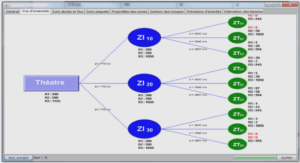Types of input data
We have benefited of several types of data in order to obtain the thermal emission of a variety Earth-like planets. First, we have used high-resolution thermal emission data of the Earth (Section 3.1), the data are implemented with satellite observations and validated by ground measurements, thus the time series built by the model is an accurate reproduction of an ideally observed light curve of the Earth. Second, we have used global climate model (GCM) simulations (Section 3.2) and by the modification of some specific parameters, we have build the thermal emission of nine Earth-like planets, including the Earth for validation (Section 3.2.1). Finally, we have simulated some of the planets of the previous set by a generic spectral version of the LMD GCM (Section 3.3). Adding the spectral information to the time series, allows us to determine the contribution to the emission, the state and the dynamics of important atmospheric species as carbon dioxide or water vapor. Some of these compounds are called biomarkers as their abundances may indicate the presence of life.
In Chapter 4, we simulate the thermal emission of the Earth using top-of-the- atmosphere (TOA) all-sky upward longwave (LW) flux maps integrated over the 5- 50 µm wavelength interval. The data were obtained from the NASA Langley Research Center Atmospheric Sciences Data Center, they belong to the NASA/GEWEX SRB (ISCCP; Rossow et al. (1996), the Goddard EOS Data Assimilation System level- 43 (GEOS-4), the Total Ozone Mapping Spectrometer4 (TOMS) archive, and the TIROS Operational Vertical Sounder5 (TOVS) data set. An assessment of the quality of the global fluxes was accomplished by comparisonswith corresponding ground measurements obtained from the Baseline Surface Radiation Network (BSRN), the Swiss Federal Institute of Technology’s Global Energy Balance Archive (GEBA) and NOAA’s Climate Montitoring and Diagnosticsperiod from 1983 to 2005. A typical map of the outgoing mid-infrared radiation of the Earth, directly represented from the GEWEX data, is shown in Figure 3.5 (left). The map represent the average flux over the period 18:00–21:00 UT for 1 July 2001. It is important to note that in mid-infrared maps, desert zones such as the Sahara- Arabian region appear as warm spots and cold or very humid regions such as clouds over the Antarctica or Indonesia appear as cold spots.
LMDZ GCM data
In chapters 5 and 6, we use Earth-like planet simulations build with the LMDZ GCM, a Global Climate Model developed by the Laboratoire de M´ Dynamique de Paris6. The model has 48 grid points regularly spaced in latitude and longitude, yielding a horizontal resolution of 3.75 by 7.5 degrees, and 19 atmospheric pressure levels on the vertical dimension. Sub-grid scale processes such as radiative transfer, clouds, convection, and small-scale turbulence are parameterized as described in Hourdin et al. (2006). The 2-dimensional fields used to compute the thermal emission are output every 3 hours, giving the same time resolution than SRB data. In water-world simulations, the surface is covered by a global ocean – a configuration known as an “aquaplanet” – modeled by a “slab” of a uniform depth of 50 m representing the oceanic surface mixed layer. The evolution of the slab temperature is determined by the surface energy fluxes, as well as heat transport by horizontal diffusion and parameterized wind-driven ocean currents (Codron, 2012). In addition, a simple thermodynamic sea-ice model is used wherever the surface temperature drops below freezing.
Earth for both SRB (Chapter 4) and LMDZ GCM (Chapter 5) models. Whereas NASA-GEWEX SRB model is implemented and validated by satellite and ground- based observations, LMDZ calculates the meteorological variables, the transport of numerous constituents (aerosols, chemical compounds of the atmosphere, radio- elements, stable water isotopes, etc…) and benefits from several models to obtain variables such as the vegetation cover, the cycles of water and carbon, the ocean circulation, the marine biochemistry or the dynamics of sea ice.The main differences between the two models (Fig. 3.1) are the horizontal resolution, which is of 1 by 1 degrees in the case of the SRB model and of 3.75 by 7.5 degrees in the case of the LMDZ model, and the cloud covering. Unfortunately, the representation of clouds in climate models is still unsatisfying. Most cloud properties cannot be resolved by global-scale models and they have to be parameterized in terms of the model variables. Clouds cover the Earth’s surface by about 70% and have a very strong effect on the radiation balance of the planet (Section 2.2). Parameterizations are complicated by the fact that clouds cover a large range of scales(from microphysics to meso-scale systems), and moreover liquid and ice phases have to be treated separately. Cloud water is predicted by a budget equation where both ice and liquid phases have to be considered jointly. The condensation scheme uses a “hat” probability density function for total water in a grid box, which allows to account for fractional cloudiness, and then the total condensed water is partitioned between liquid water and ice, depending on the local temperature. LMDZ GCM LW cloud radiative forcing has been validated by satellite observations. Doutriaux-Boucher & Quaas (2004) found a discrepancy up to the 40% for mid- and high-latitudes. However, equatorial latitudes, which account for most of the emission, fit to the observations and then global climate parameters are valid.




